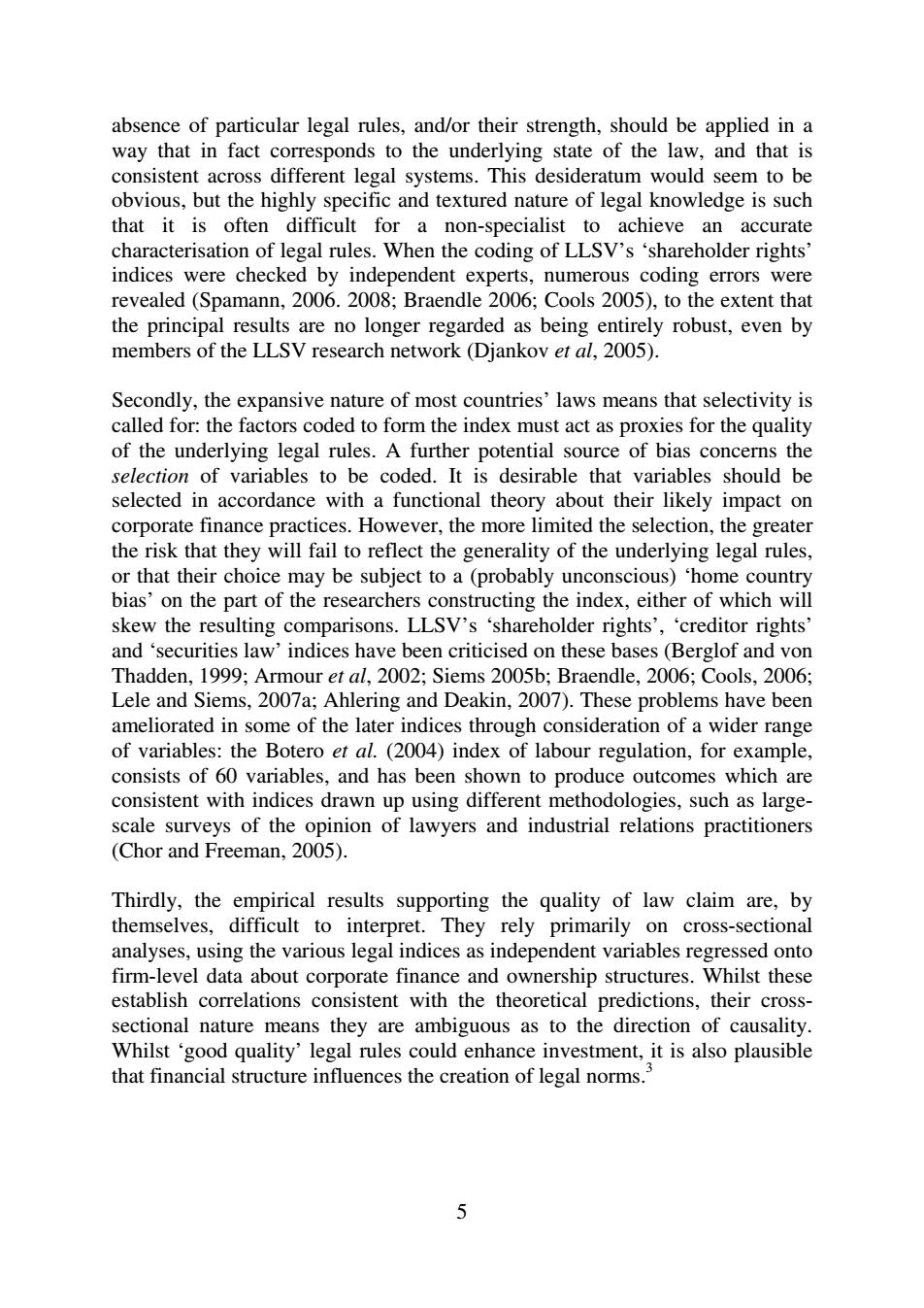正在加载图片...

absence of particular legal rules,and/or their strength,should be applied in a way that in fact corresponds to the underlying state of the law,and that is consistent across different legal systems.This desideratum would seem to be obvious,but the highly specific and textured nature of legal knowledge is such that it is often difficult for a non-specialist to achieve an accurate characterisation of legal rules.When the coding of LLSV's 'shareholder rights' indices were checked by independent experts,numerous coding errors were revealed (Spamann,2006.2008;Braendle 2006;Cools 2005),to the extent that the principal results are no longer regarded as being entirely robust,even by members of the LLSV research network (Djankov et al,2005). Secondly,the expansive nature of most countries'laws means that selectivity is called for:the factors coded to form the index must act as proxies for the quality of the underlying legal rules.A further potential source of bias concerns the selection of variables to be coded.It is desirable that variables should be selected in accordance with a functional theory about their likely impact on corporate finance practices.However,the more limited the selection,the greater the risk that they will fail to reflect the generality of the underlying legal rules, or that their choice may be subject to a(probably unconscious)home country bias'on the part of the researchers constructing the index,either of which will skew the resulting comparisons.LLSV's 'shareholder rights',creditor rights' and securities law'indices have been criticised on these bases (Berglof and von Thadden,1999;Armour et al,2002;Siems 2005b;Braendle,2006;Cools,2006; Lele and Siems,2007a;Ahlering and Deakin,2007).These problems have been ameliorated in some of the later indices through consideration of a wider range of variables:the Botero et al.(2004)index of labour regulation,for example, consists of 60 variables,and has been shown to produce outcomes which are consistent with indices drawn up using different methodologies,such as large- scale surveys of the opinion of lawyers and industrial relations practitioners (Chor and Freeman,2005). Thirdly,the empirical results supporting the quality of law claim are,by themselves,difficult to interpret.They rely primarily on cross-sectional analyses,using the various legal indices as independent variables regressed onto firm-level data about corporate finance and ownership structures.Whilst these establish correlations consistent with the theoretical predictions,their cross- sectional nature means they are ambiguous as to the direction of causality. Whilst 'good quality'legal rules could enhance investment,it is also plausible that financial structure influences the creation of legal norms. 55 absence of particular legal rules, and/or their strength, should be applied in a way that in fact corresponds to the underlying state of the law, and that is consistent across different legal systems. This desideratum would seem to be obvious, but the highly specific and textured nature of legal knowledge is such that it is often difficult for a non-specialist to achieve an accurate characterisation of legal rules. When the coding of LLSV’s ‘shareholder rights’ indices were checked by independent experts, numerous coding errors were revealed (Spamann, 2006. 2008; Braendle 2006; Cools 2005), to the extent that the principal results are no longer regarded as being entirely robust, even by members of the LLSV research network (Djankov et al, 2005). Secondly, the expansive nature of most countries’ laws means that selectivity is called for: the factors coded to form the index must act as proxies for the quality of the underlying legal rules. A further potential source of bias concerns the selection of variables to be coded. It is desirable that variables should be selected in accordance with a functional theory about their likely impact on corporate finance practices. However, the more limited the selection, the greater the risk that they will fail to reflect the generality of the underlying legal rules, or that their choice may be subject to a (probably unconscious) ‘home country bias’ on the part of the researchers constructing the index, either of which will skew the resulting comparisons. LLSV’s ‘shareholder rights’, ‘creditor rights’ and ‘securities law’ indices have been criticised on these bases (Berglof and von Thadden, 1999; Armour et al, 2002; Siems 2005b; Braendle, 2006; Cools, 2006; Lele and Siems, 2007a; Ahlering and Deakin, 2007). These problems have been ameliorated in some of the later indices through consideration of a wider range of variables: the Botero et al. (2004) index of labour regulation, for example, consists of 60 variables, and has been shown to produce outcomes which are consistent with indices drawn up using different methodologies, such as largescale surveys of the opinion of lawyers and industrial relations practitioners (Chor and Freeman, 2005). Thirdly, the empirical results supporting the quality of law claim are, by themselves, difficult to interpret. They rely primarily on cross-sectional analyses, using the various legal indices as independent variables regressed onto firm-level data about corporate finance and ownership structures. Whilst these establish correlations consistent with the theoretical predictions, their crosssectional nature means they are ambiguous as to the direction of causality. Whilst ‘good quality’ legal rules could enhance investment, it is also plausible that financial structure influences the creation of legal norms.3